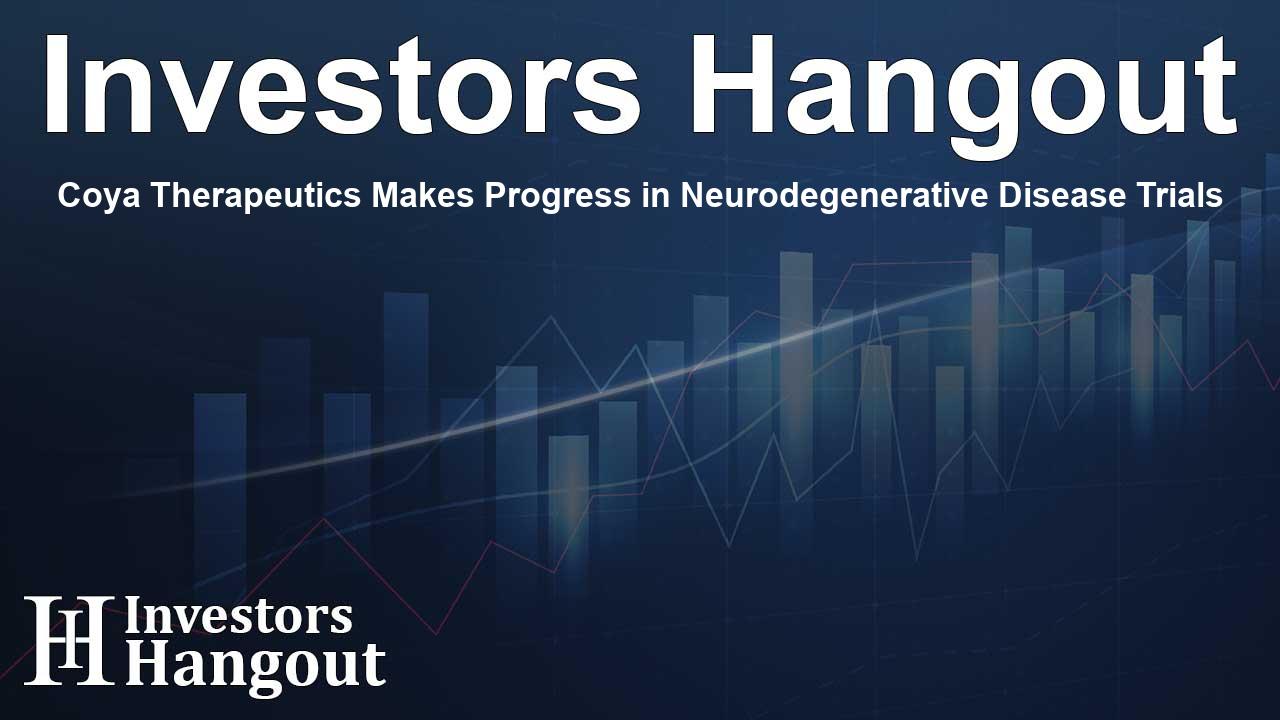Coya Therapeutics Makes Progress in Neurodegenerative Disease Trials

Coya Therapeutics Advances in Neurodegenerative Disease Research
Recently, Coya Therapeutics, Inc. (NASDAQ: COYA) has been making notable strides in its clinical research endeavors. This clinical-stage biotech firm, based in Houston, has an impressive market capitalization of approximately $93.73 million and recently traded at $5.61 per share. The company has announced the successful enrollment of five participants in its Phase 1 study targeting Frontotemporal Dementia (FTD) at Houston Methodist Hospital.
Understanding the Study and Its Implications
This Phase 1 study, under the guidance of leading researchers Dr. Stanley Appel and Dr. Alireza Faridar, is integral as it evaluates a combination therapy utilizing low-dose IL-2 and CTLA4-Ig. The outcomes from this study will significantly shape the design of a forthcoming randomized and double-blinded Phase 2 trial aimed at addressing FTD.
Details About the Investigational Therapy COYA 302
COYA 302 combines low-dose interleukin-2 with CTLA4-Ig, aiming to amplify the function of regulatory T cells (Tregs) and reduce inflammation both peripherally and centrally. The rationale behind this combination is to foster an improved therapeutic approach for those suffering from FTD, which can also potentially extend its benefits to various other neurodegenerative diseases.
The Importance of Tregs in FTD Treatment
Coya's President and Chief Medical Officer, Fred Grossman D.O., has stated that findings from the ongoing study will inform the design features for the subsequent Phase 2 trial. Recently, the company was awarded a substantial $5 million grant from the Alzheimer’s Drug Discovery Foundation (ADDF) to further the development of COYA 302 for treating FTD.
Insights Into Frontotemporal Dementia
FTD is classified as a rare form of dementia with damaging effects on neurons located in the frontal and temporal lobes of the brain. Symptoms can range from behavioral changes to difficulties in communication; unfortunately, no current treatments exist that can halt its progression, emphasizing the critical need for effective therapies.
Market Perspective and Analyst Predictions
The current study follows insights shared during a recent AD/PD conference, where it was revealed that Treg suppressive functions are significantly compromised in FTD patients. In light of this, the market has shown a promising outlook towards COYA, with analyst price targets estimating shares will range between $14 and $18.
Expanding COYA 302's Applications
Coya's investigational therapy is not limited to FTD but is also being studied for conditions such as Amyotrophic Lateral Sclerosis (ALS), Parkinson’s Disease (PD), and Alzheimer’s Disease. Prior studies indicated COYA 302's favorable tolerance in ALS patients, showcasing potential signs of slowing disease progression.
Company Strength and Financial Health
Coya Therapeutics focuses on addressing systemic inflammation and neuroinflammation through innovative therapeutic strategies targeting Tregs. The company demonstrates a robust financial profile, characterized by higher cash holdings than debt, and a high current ratio of 15.31, signaling solid liquidity conditions. Current assessments rate Coya as enjoying “GOOD” financial health as per various evaluations.
Recent Developments and Future Outlook
The company has recently seen beneficial changes, including coverage initiation by Boral Capital, which assigned a Buy rating, underscoring its innovative methodologies in neurodegenerative disorder treatments. Coya Therapeutics is preparing for a data submission associated with its Phase 2 study of COYA 302 by mid-2025 and anticipates outcomes from an ongoing open-label study in FTD later that same year.
Leadership Changes Reflect Commitment
A recent reshuffle in leadership included Dr. Hideki Garren's resignation from the Board of Directors, while Dr. Arun Swaminathan stepped into the CEO role. These changes reflect the organization’s ongoing commitment to driving advances in neurodegenerative disease research.
Frequently Asked Questions
What is the focus of Coya Therapeutics?
Coya Therapeutics focuses on developing innovative treatments for neurodegenerative diseases, emphasizing systemic and neuroinflammation through regulatory T cells.
What is COYA 302?
COYA 302 is an investigational therapy that combines low-dose IL-2 with CTLA4-Ig aimed at enhancing Treg function to combat conditions like Frontotemporal Dementia.
What insights emerged from recent studies regarding Tregs?
Recent studies indicated that Treg function is significantly reduced in FTD patients, which could be crucial in understanding the disease's pathophysiology.
How is Coya Therapeutics financially positioned?
Coya maintains a strong financial position, with more cash than debt and excellent liquidity, reflecting solid fundamentals despite its clinical stage.
When can we expect results from the study?
Results from the ongoing open-label study in the second half of 2025 will provide critical insights into its investigational therapeutics for neurodegenerative diseases.
About Investors Hangout
Investors Hangout is a leading online stock forum for financial discussion and learning, offering a wide range of free tools and resources. It draws in traders of all levels, who exchange market knowledge, investigate trading tactics, and keep an eye on industry developments in real time. Featuring financial articles, stock message boards, quotes, charts, company profiles, and live news updates. Through cooperative learning and a wealth of informational resources, it helps users from novices creating their first portfolios to experts honing their techniques. Join Investors Hangout today: https://investorshangout.com/
Disclaimer: The content of this article is solely for general informational purposes only; it does not represent legal, financial, or investment advice. Investors Hangout does not offer financial advice; the author is not a licensed financial advisor. Consult a qualified advisor before making any financial or investment decisions based on this article. The author's interpretation of publicly available data shapes the opinions presented here; as a result, they should not be taken as advice to purchase, sell, or hold any securities mentioned or any other investments. The author does not guarantee the accuracy, completeness, or timeliness of any material, providing it "as is." Information and market conditions may change; past performance is not indicative of future outcomes. If any of the material offered here is inaccurate, please contact us for corrections.